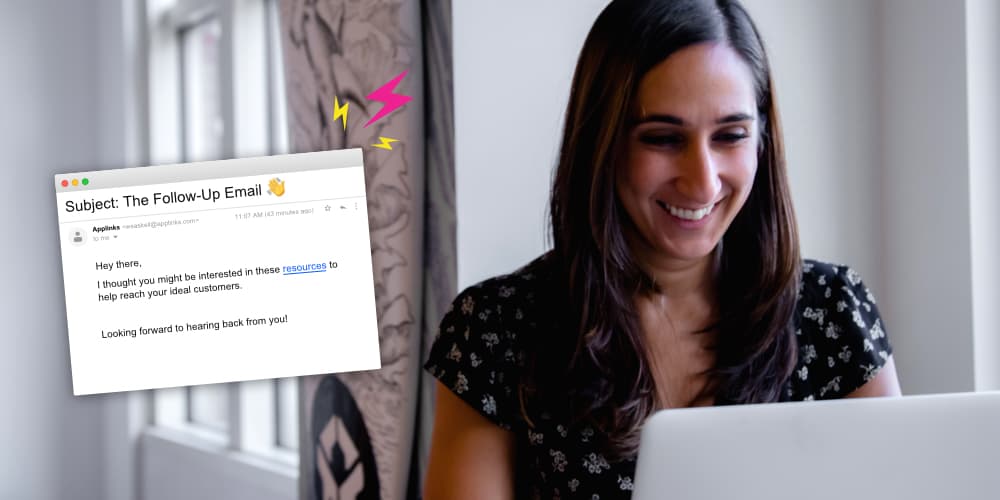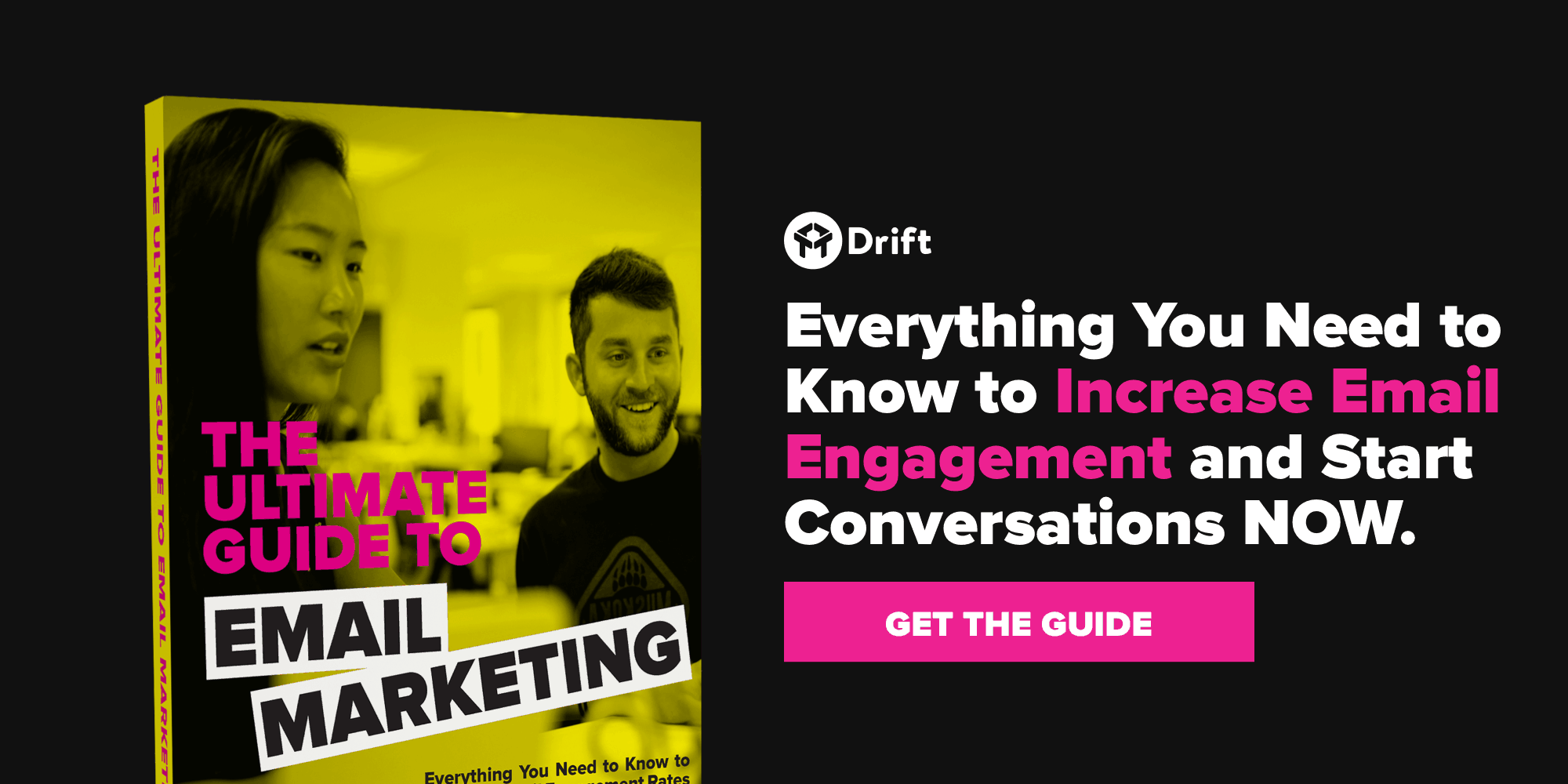
Circling back, checking in, or maybe touching base. In any case, if you’re reaching out to make sure someone got your last email, there’s a chance you’re rubbing your prospects the wrong way. Sorry to be the bearer of bad news.
That said, following up is an essential part of the sales process. Around 38% of salespeople say that getting a response from prospects is harder than ever, and statistically, it takes between 5 and 13 follow-ups to seal the deal.
Even though persistence pays off, a whopping 92% of sales reps throw in the towel after just four “no” replies.
So, the follow-up email—it’s an art worth perfecting and a concept worth getting used to.
In this article, we’ll go over some best practices for writing follow-up emails and some examples of winners you can apply to your own follow-up efforts.
Bad Follow-Up Emails
Before we dive into some examples of good follow-up emails, it’s worth highlighting a handful of mistakes you’ll want to avoid.
- Don’t Write Too Much–Sales emails should be short and direct. Try to keep things within the 3-5 sentences range. If the prospect feels like reading, they’ll download an e-book or poke around in your knowledge base.
- Don’t Repeat the Same Content–A good rule of thumb is, every email should offer something new.
- Don’t Ask for Too Much–If you’re following up with an early-stage prospect, you might scare them away by asking them to close right away. Make sure each communication corresponds with where this person is in their buying journey.
Here are a few examples of what a “bad” follow-up email might look like:
Hi [Name],
I didn’t hear back from you last week when I was looking for the appropriate person managing the content marketing of [Business Name]. If it makes sense to talk, let me know how your calendar looks. If not, who is the appropriate person?
ThanksHey [Name], how’s it going? Can we schedule some time to talk this week?
Cheers[Name], is the below of any interest to you?
These might not seem so bad at a glance. However, once you take a closer look, you’ll notice that there’s nothing of value inside.
This rep makes things all about them, not the prospect. Think about it this way–would you be compelled to act on an offer that doesn’t clearly meet your needs? Probably not.
Anatomy of a Follow-Up Email
- Subject Line—Follow-up subject lines should quickly let the recipient know what they can expect to find inside the email.
- Context—Though the email subject line should give prospects a sense of why you’re contacting them, use the opening line to explain yourself a bit more. If you met this person at an event—bring it up. If they’re an inbound lead you’ve never spoken with, do some research.
- Value Proposition—What problem are you solving? Instead of passing along information, make sure every follow-up email you send offers some value to your users.
- Social Proof— Roughly 70% of US consumers look to reviews before making a purchase and 84% value reviews from strangers as much as a recommendation from a friend. Social proof isn’t just reviews and testimonials. You can link to specific results, case studies, original research, or link to your best content.
- CTA—Sign off with a focused call-to-action. This might be a link to chat, booking a call, a download you think this person might like, etc.
Follow Up Email – After a First Meeting
If you’re following up after a meeting or a sales call, this is an excellent opportunity to keep up the momentum and build a positive relationship. What’s great about this situation is, whoever you’re trying to reach is probably invested in this relationship—they just met with you after all.
However, even if you think everything went great and the prospect is ready to sign, what was discussed during that meeting can fall by the wayside if you don’t follow up soon after.
Following Up with an Inbound Lead
The best way to follow up with an inbound lead comes down to context—what referral source did this person come from? Which page were they on when they asked your chatbot a question?
These days, we’re all well-aware of the fact that our online behavior from sign-ups to downloads are often being tracked.
Still just because someone downloads a case study doesn’t mean they’re interested in talking to a sales rep right away.
Pay close attention to what content this prospect has interacted with, as it can give you some clues as to where they’re at in the buying cycle.
This example from Pipedrive goes straight for the elephant in the room—I see you’re interested in [company].
We like the “I hope this doesn’t seem creepy” approach, as it acknowledges the tools of the trade and how they sometimes violate social norms.
Hi [Name]
I hope this doesn’t seem creepy, but I see that you have read my previous email and visited our site (the wonders of modern technology). I think this will be a very good time for us to take the conversation further.
Please let me know when I can schedule time to come and see you and take you through my plan on how we could work together.
I look forward to hearing back from you.
[Signature]
After Leaving a Voicemail
Okay, let’s say that you’ve called a prospect and they didn’t pick up.
This probably happens all the time, as let’s face it, few of us are willing to answer a call from an unknown number these days.
The case for voicemail (or not) is a contested one, best reserved for another post. But, if you make a call and don’t leave a voicemail, it might seem odd or annoying to the prospect.
Plus, the voicemail-email combo is the perfect way to cover two touchpoints back to back.
Does doubling down here seem like overkill?
Maybe, but following up right after a voicemail provides prospects with multiple ways to get back in touch. People aren’t always able to answer every incoming call—especially if that call is coming from a sales rep.
However, they may be able to answer an email from their mobile device instead.
Here’s one that does an excellent job rehashing the value prop from the initial email.Short, sweet, and they cut right to the chase–what’s in it for the customer.
“Hi Tim,
I left you a voicemail earlier today to schedule a time to demo Call Logic. We’re excited to show you how we help our clients save time and close more outbound calls.
I mentioned that I’d call again on Tuesday at 10:00 a.m., but feel free to contact me by email if that works better for you.
Looking forward to learning more about your business!
Best,
[Your name and title]”
And this SUPER short example:
“Hi (Prospects Name). I left you a voicemail the other day regarding…” (now repeat your first time voicemail message, including your name and number twice at the end)
While this one kind of breaks the rule of offering something different each time you reach out, keep in mind, many people don’t check their voicemail.
Additionally, you’ll also have an opportunity to link to any resources that help paint a better picture of the offer you included in the voicemail.
After a Lapsed Free Trial
So, a hot prospect signed up for the two-week trial but never converted. They must not like the product, or maybe they found something better. Time to give up, right?
Actually, it might still be worth another shot.
Use this as an opportunity to invite this user back for another trial—maybe they didn’t get a chance to look around. Perhaps they forgot and ran out of time. In any case, people get busy, and you never know why someone opted out unless they tell you themselves.
Here’s a nice example from Reply.io. This email falls toward the end of a larger follow-up sequence, using social proof and the chance to come back for another test run.
Subj: Re: Reply email engine
Hi {FirstName},
At Reply, we attracted customers using our own software to follow up on leads for outbound.
In six months we received thousands of inbound trials and hundreds of customers because we did one simple thing. We automated the outbound process and tested messaging until we saw the results of our campaigns.If you’re still sending emails manually, come back to Reply and give us another try.
25 Subject Lines for Follow-Up Emails
You can’t talk about email–follow-up or otherwise–without spending some time talking subject lines. Subject lines are the catchy headline that gets the recipient to click and see what you have to say.
As we mention in our Email Marketing Guide, winning subject lines tend to be short (like, 3-6 words) and they give readers a sense of what they’ll find inside. Here’s a look at 25 subject line “templates” of sorts that you can use to make sure that your next round of follow-ups won’t go unnoticed.
Following Up on Inbound Leads:
- [Your Name/Company]– Introduction
- How are you handling [x pain point]?
- [Prospect name], some resources to help with [pain point]
- Here’s that [case study/e-book/quote] you requested
- First steps toward improving [pain point]
After a Meeting:
- [Name], here’s the marketing plan we discussed
- Hey, [First Name] a few ideas for [x goal/challenge]
- A few more resources for [pain point discussed]
- Question about [goal discussed]
- [Name]—I thought you might be interested in these [blogs/articles/resources]
- Our next steps
Voicemail Follow-Up:
- Is there a better time to talk?
- Tried to call you just now
- Meeting invite [date]
After an Event:
- Hey, [Name], I’m glad we crossed paths at [event]
- Following up from [event]
- Great to see you at [event]!
- A few thoughts about [issue discussed]
- Thinking about [goal discussed]
If You Haven’t Heard Back:
- A few things you should know about [your company]
- This might be of interest to you, [name]
- Missed you again
- Last chance to get [specific offer]
- Still making [X mistake]?
- [Name], what went wrong?
Final Thoughts
In the end, it might take several follow up emails (and calls, DMs, and chats) to close a deal. The tips and templates outlined above will help you fine-tune this important email-based art form, and with practice, help you close more deals.
For more email advice, check out our Ultimate Guide to Email Marketing. Also check out some of our other posts about email:
- Steal These 6 Nurture Email Templates To Automatically Get More Replies
- We’re Introducing 3 Email Bots – So You Can Transform Your Marketing Emails Into Conversations & Make Buying Easier
- Welcome Emails – How to Engage & Activate New Customers
- Email Design Best Practices
- Effective Sales Email Templates You Can Use To Get Meetings Today




